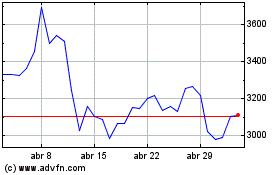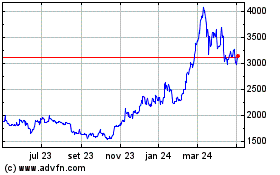11% Of Bitcoin Supply In Coinbase’s Hands: Analyzing The Potential Risks
11 Setembro 2024 - 9:30PM
NEWSBTC
A recent report by The Defiant reveals that Coinbase holds a
substantial 11% of the total Bitcoin supply, amounting to
approximately 2.275 million BTC worth around $129 billion. As
the fourth-largest cryptocurrency exchange globally, Coinbase
commands significant trading volume—$1.5 billion in 24-hour
transactions and 34 million monthly users—and acts as a custodian
for major corporations, including BlackRock, Tesla, and
MicroStrategy. However, this substantial concentration of Bitcoin
within a single entity has raised important questions about the
potential risks associated with such centralization. The
Fallout Of A Potential Coinbase Disaster Per the report, critics
argue that a significant concentration of assets can lead to
systemic risks, particularly if the exchange were to face security
issues, legal pressures, or other crises. Related Reading:
Analyst Says Bitcoin Is In A ‘Healthier’ Place Now, Here’s Why
Jameson Lopp, CTO of multi-sig custodian Casa, points out that
while Coinbase is considered more stable than many exchanges, it
remains vulnerable to pressures from nation-states and could face
scenarios akin to the US government’s historical seizure of gold
during the 1930s. The implications of a Coinbase disaster—such as a
hack resulting in the loss of customer funds—could reverberate
throughout the cryptocurrency market. Such an event would not only
undermine public confidence in crypto but could also lead to a
significant downturn in market prices, potentially triggering a
prolonged bear market. The report notes that the fear is
compounded by the fact that more than 73 million Americans hold
accounts on the platform, meaning the fallout could affect a vast
number of retail investors. Could A Bitcoin Fork Be On The
Horizon? While some experts, like Steven Lubka from Swan
Private, believe a catastrophic loss is unlikely due to Coinbase’s
“advanced security measures,” the risk of custodial centralization
remains a concern. The idea of a Bitcoin fork to recover lost
assets—similar to the Ethereum situation following the DAO hack in
2016—has been suggested. However, experts believe that while
influential stakeholders might push for a rollback to “recover”
their funds, the decentralized nature of Bitcoin’s network would
likely reject such proposals. Lisa Neigut, founder of Base58,
explains that Bitcoin’s unique Unspent Transaction Output (UTXO)
model creates a buffer against centralized risks. In this model, if
a bug affects a particular entity’s keys, it only impacts that
entity, preserving the overall integrity of the network. This
separation of concerns is crucial for maintaining the health of the
Bitcoin protocol, especially in the face of potential
centralization threats. Yet, concerns persist about how large
custodians like Coinbase could influence the broader
ecosystem. Related Reading: Is Chainlink (LINK) $12 Breakout
Imminent? Data Reveals A Rising Open Interest Armin Sabouri, CTO of
Botanix Labs, warns that significant holders could coerce the
community by threatening to dump their assets, potentially crashing
the market price and forcing the network to ossify in response to
their demands. This scenario poses a direct challenge to Bitcoin’s
foundational ethos of decentralization. In sum, the sense of risk
regarding the increased amount of holdings that the exchange poses
remains a topic for debate in the future of the market. In
addition, with the increased amount of methods to potentially hack
or attempt to hack exchanges like Coinbase, it would be imperative
to monitor and prevent these types of scenarios to avoid another
Mt. Gox catastrophe. At the time of writing, Bitcoin was trading at
$57,650, having failed to break above the $58,000 resistance level
for two days in a row. Featured image from DALL-E, chart from
TradingView.com
Ethereum (COIN:ETHUSD)
Gráfico Histórico do Ativo
De Dez 2024 até Jan 2025

Ethereum (COIN:ETHUSD)
Gráfico Histórico do Ativo
De Jan 2024 até Jan 2025
